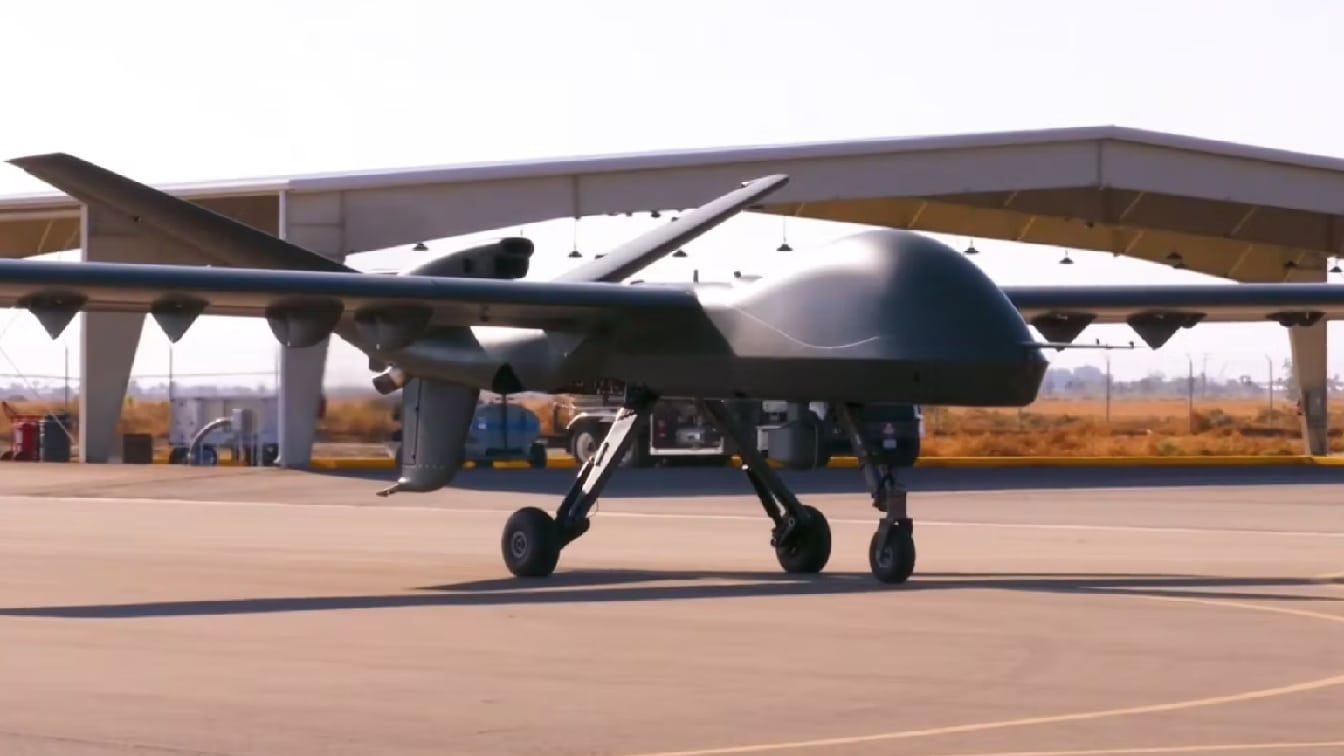Hellfire missiles, miniguns capable of firing thousands of rounds per minute, advanced sensors, and short take-off capabilities are some of the “goodies” the Mojave drone promises to bring.
General Atomics, the manufacturer, first revealed the unmanned aerial system in December. Now, a few weeks later, the defense company came out with a set of new pictures that better show the capabilities of the Mojave.
The Future of Close Air Support?
The Mojave unmanned aerial system specializes in armed overwatch, attack, and armed reconnaissance operations, with an emphasis on expeditionary missions.
The new pictures of the unmanned aerial system show the Mojave sporting two Dillon Aero miniguns. The Dillon Aero Gun Pod is a self-contained weapon system with an internal power system that supports the M134D-H machine gun. The weapon has a rate of fire of 3,000 rounds per minute, a magazine capacity of 3,000 rounds, and uses 7.62x51mm NATO bullets with M13 links.
With a payload capacity of 3,600 pounds (a bit more than 1,600 kilograms), the Mojave can pack an impressive 16 Hellfire missiles or equivalent munitions in seven external hardpoints. As a result, the unmanned aerial system can stay on target and support troops on the ground for longer periods of time because it doesn’t have to return to base to rearm. This ability to loiter more makes it a great platform to support conventional or special operations troops on the ground.
In addition to its armament, the Mojave can carry advanced sensors, including Electro-optical/Infrared (EO/IR), Synthetic Aperture Radar/Ground Moving Target Indicator (SAR/GMTI), and Signal Intelligence (SIGINT) equipment.
“We’re proud to bring these extraordinary capabilities to our Predator line of UAS. We are providing the ground force with a long-endurance, armed overwatch UAS that can quickly reload weapons at austere sites, located close to the conflict zone. This revolutionary design, based on 7 million flight hours of UAS experience, increases expeditionary employment options – making Mojave a real game changer,” Linden Blue, the Chief Executive Officer of said GA-ASI, said in a press release back in December when the Mojave unmanned aerial system was first introduced to the public.
The prototype of the unmanned aerial system first flew last summer.
According to General Atomics, the Mojave drone is based on the avionics and flight control systems of the venerable MQ-9 Reaper and MQ-1C Gray Eagle-ER unmanned aerial systems. However, what makes it different from these drones is increased firepower and, more importantly, its Short-Takeoff and Landing (STOL) capability, which allows the Mojave to take off from very short distances.
For example, for an Intelligence, Surveillance, and Reconnaissance (ISR) mission, the Mojave needs only 122 meters (400 feet) of runway. In comparison, an F-16V Fighting Falcon needs at least 460 meters (1,500 feet) to take off. The unmanned aerial systems’ STOL capability means that the drone can operate from almost anywhere in the world, including aircraft carriers and amphibious landing ships, opening the way for more maritime-related activities. But to achieve carrier-based operations, General Atomics will need to find a way to launch the unmanned aerial system without a catapult and recover it without arresting gear.
“The Mojave project brings together all the best of the proven technologies for employment, sustainment and production and capability to achieve industry-leading reliability, range and endurance. STOL capability increases the number of employment options available to Mojave, potentially including aircraft carrier-based options, unlocking naval missions or sea-based support for special operations forces,” General Atomics stated in a press release.
The Mojave operates a Rolls Royce M250 450 horsepower turboprop engine and has a maximum endurance of 25 hours.
“Remotely piloted aircraft are one of the best CAS [close air support] platforms out there. They can stay on target for a long time and have the capability to support ground troops with not only precision strikes but with valuable intelligence through their sensors,” a former Air Force Combat Controller told 19FortyFive.
Armed Overwatch
The development of the Mojave unmanned aerial system also raises some questions about the future of close air support. The U.S. Special Operations Command (SOCOM) has been “fighting” with the Air Force for years now about the future of close air support.
What SOCOM seeks from the Armed Overwatch Program is a deployable, affordable, and sustainable manned platform with the ability to conduct Close Air Support (CAS), Armed Intelligence, Surveillance, and Reconnaissance (Armed ISR), Strike Coordination & Reconnaissance (SCAR), and Forward Air Control (FAC) operations.
Being at the tip of the spear, often operating behind enemy lines in small numbers, makes special operators regular customers for close air support sorties. As a result, with the Armed Overwatch Program, SOCOM wants its own fleet of aircraft that can conduct close air support.
On the other hand, the Air Force was pursuing its own program for the exact same mission set, causing delays and frustration on both ends.
An aircraft such as the Mojave—which is unmanned, contrary to SOCOM’s desire—could prove a solution for both as it has a good loiter time and weapons capacity in addition to the STOL capability that makes it a great option for supporting special operations forces.
1945’s New Defense and National Security Columnist, Stavros Atlamazoglou is a defense journalist specializing in special operations, a Hellenic Army veteran (national service with the 575th Marine Battalion and Army HQ), and a Johns Hopkins University graduate.

